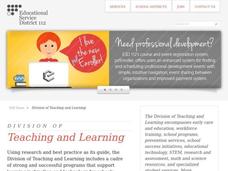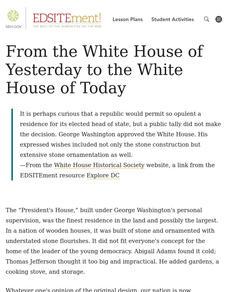Curated OER
National Road to Indiana
Learners explore the National Road to Indiana. In this U.S. highway history and primary source research lesson, students read an original journal written by Jane Voorhees Lewis in 1806 describing her trip west on the first federally...
Curated OER
1920’s Questions
In this 20th century history worksheet, students respond to 50 multiple choice questions about events and significant figures of 1920's America.
Curated OER
People From American History
In this social studies worksheet, 4th graders will gain an understanding of nine famous Americans and their accomplishments to society. Students will complete nine fill in the blank statements about each individual.
Curated OER
The Treaty Trail: Examining an Artist's Perspective
Elementary school leanrners examine artwork from the time period of the United States and Native American treaties. They discuss the causes and effects of the treaties being signed. They also examine how cultural perspective influences art.
Curated OER
U.S. and Canada: How are We the Same? How are We Different?
Get high school geographers to compare and contrast Canada and the United States. They begin by drawing a freehand map of North America, then complete readings to gain insight into Canada. The text is not provided; however, another text...
Curated OER
Ancient Chinese Tomb Building
Young scholars compare and contrast the monuments erected for George Washington, the first president of the United States, and Qin Shi Huangdi (r. 221- 210 BCE), the first emperor of China. This lesson also includes a creative project.
Curated OER
BIRTH OF AN EXCEPTIONAL NATION
Students compare the 2 paintings "Washington Crossing the Delaware" and "Prayer at Valley Forge". Look for similarities, differences and information on the painters. Create a political game board using the events from 1776.
Curated OER
Early Presidents and Politics
Students investigate early presidents of the United States. Students complete a series of lessons in which they research the contributions and political climate during the terms of U.S. presidents from George Washington to Andrew Jackson.
Curated OER
Father Knows Best
Students recognize that history describes events and people of other times and places identifying George Washington by historical account. They describe everyday life in the present and in the past and begin to recognize that things...
Curated OER
Arrest of the Maryland Legislature
For this Civil War history worksheet, students read and discuss a selection regarding the arrest of the Maryland legislature.
Curated OER
Judicial Review
Student demonstrate understanding of both sides of the argument between Jefferson and Marshall that led to the strengthening of the Judicial Branch through the creation of judicial review. Unit is comprised of five lessons and fits into...
Curated OER
Lincoln Home National Historic Site: A Place of Growth and Memory
Eighth graders study the history of Lincoln's home. In this American History lesson, 8th graders examine artifacts from his home to learn about his beliefs. Students participate in a webquest on Lincoln's home.
Curated OER
The future of Affirmative Action
Eleventh graders explore the term Affirmative Action. For this US History lesson, 11th graders create a presentation that will determine the future of federal affirmative action programs. Students write a speech that will be...
Curated OER
Japaneses Internment: Lesson 1 of 4: Chronological Events Leading to Internment
Young scholars examine facts about history of the Asians experience in America and identify patterns of Asian immigration in the United States. Students develop reasons specific Asian ethnic groups migrated to the United States and...
Curated OER
We The People
Students engage in this introductory unit of history which is ideal for the first few weeks of instruction. The unit is meant to prepare students for the nation wide contest associated with History Day.
Curated OER
The American Presidents (Middle, History)
Eighth graders get a firm understanding of the major contributions and defining characteristics of the American Presidents.
Curated OER
From the White House of Yesterday to the White House of Today
Young scholars take a close look at the design of the White House and some of the changes it has undergone. They also reflect on how the "President's House" has been and continues to be used. They give specific examples demonstrating how...
Curated OER
Monuments, Memorials and Public Spaces
Monument and memorial lesson plans can get students thinking about important topics and time periods in history.
Curated OER
McCarthyism: 60 Years Later
Explore legendary cartoonist Herb Block's bold challenge of McCarthy-era politics through this analysis activity. Two cartoons are included, along with talking points to prompt analysis and background information to help pupils "read...
Curated OER
The U.S. Holocaust Memorial Museum
Ninth graders visit the US Holocaust Museum to witness the actions of the Nazis against the Jews during World War II. A great lesson if you are located near the museum or are planning a trip to the DC area.
Smithsonian Institution
Students’ Response to 9/11—A Documentary Report
Young historians research the devastating attacks of 9/11 and use that information to script their own documentaries. The follow-up activity includes recording the documentary and conducting classmate interviews,
NPR
Civil Rights of Japanese-American Internees
Prompted by a viewing of Emiko and Chizu Omori’s Rabbit in the Moon, a documentary about the internment of Japanese-Americans during World War II, high schoolers examine a series of documents, including the Bill of Rights and the UN’s...
Heritage Foundation
Substantive Amendments: Amendments I and II
The First and Second Amendments remain some of the most famous, even to this day. Learners read about several clauses from the US Constitution through a variety of captivating activities including before and after reading, group work,...
Curated OER
I Am Not a Crook
Students use video, Internet research and discussion to consider the presidency of Richard Nixon. They obtain information from multiple perspectives and form an opinion of how Richard Nixon should be remembered.























